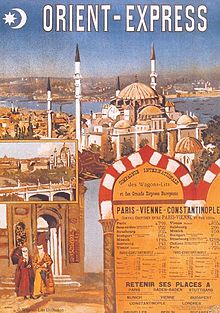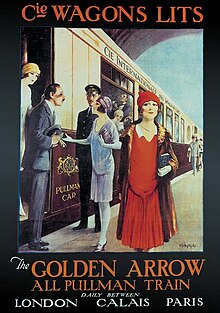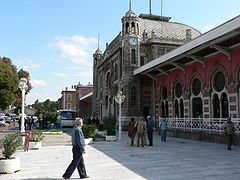| The Orient Express | |
|---|---|
 Poster advertising the winter 1888–1889 timetable | |
| Operation | |
| Began operation | 1883 |
| Ended operation | 14 December 2009 |
| Train length | 4–45 coaches |
The Orient Express was a long-distance passenger train service created in 1883 by the Belgian company Compagnie Internationale des Wagons-Lits (CIWL) that operated until 2009. The train traveled the length of continental Europe, with main terminal stations in Paris in the northwest and Istanbul in the southeast, and branches extending service to Athens, Brussels, and London.
The route and rolling stock of the Orient Express changed many times. Several routes in the past concurrently used the Orient Express name, or slight variations. Although the original Orient Express was simply a normal international railway service, the name became synonymous with intrigue and luxury rail travel. The two city names most prominently served and associated with the Orient Express are Paris and Istanbul,[1][2] the original termini of the timetabled service.[3]
In 1977, the Orient Express stopped serving Istanbul. Its immediate successor, a through overnight service from Paris to Bucharest, was later cut back in 1991 to Budapest, and in 2001 was again shortened to Vienna, before departing for the last time from Paris on Friday 8 June 2007.[4][5] After this, the route, still called the Orient Express, was shortened to start from Strasbourg instead,[6] occasioned by the inauguration of the LGV Est which afforded much shorter travel times from Paris to Strasbourg. The new curtailed service left Strasbourg at 22:20 daily, shortly after the arrival of a TGV from Paris, and was attached at Karlsruhe to the overnight sleeper service from Amsterdam to Vienna. On 14 December 2009, the Orient Express ceased to operate and the route disappeared from European railway timetables, reportedly a "victim of high-speed trains and cut-rate airlines".[7]
Since 13 December 2021, an ÖBB Nightjet again runs three times per week on the Paris-Vienna route, although not branded as Orient Express.[8] The Venice-Simplon Orient Express train, a private venture by Belmond[9] using original CIWL carriages from the 1920s and 1930s, continues to run to and from various destinations in Europe, including the original route from Paris to Istanbul.[10]

In 1882, Georges Nagelmackers, a Belgian banker's son, invited guests to a railway trip of 2,000 km (1,243 mi) on his Train Eclair de luxe ("lightning luxury train").[3][11][failed verification] The train left Paris Gare de l'Est on Tuesday, 10 October 1882, just after 18:30 and arrived in Vienna the next day at 23:20. The return trip left Vienna on Friday, 13 October at 16:40 and, as planned, re-entered the Gare de Strasbourg at 20:00 on Saturday 14 October.
Georges Nagelmackers was the founder of Compagnie Internationale des Wagons-Lits (CIWL), which expanded its luxury trains, travel agencies and hotels all over Europe, Asia, and North Africa. Its most famous train remains the Orient Express.
The train was composed of:
The first menu on board (10 October 1882): oysters, soup with Italian pasta, turbot with green sauce, chicken ‘à la chasseur’, fillet of beef with ‘château’ potatoes, ‘chaud-froid’ of game animals, lettuce, chocolate pudding, buffet of desserts.[12]


On 5 June 1883, the first Express d'Orient left Paris for Vienna via Munich. Vienna remained the terminus until 4 October 1883, when the route was extended to Giurgiu, Romania. At Giurgiu, passengers were ferried across the Danube to Ruse, Bulgaria, to pick up another train to Varna. They then completed their journey to Constantinople, as the city was still commonly called in the west at the time, by ferry. In 1885, another route began operations, this time reaching Constantinople via rail from Vienna to Belgrade and Niš, carriage to Plovdiv, and rail again to Istanbul.[13]
On 1 June 1889, the first direct train to Constantinople left Paris from Gare de l'Est. Istanbul, as it became known in English by the 1930s, remained its easternmost stop until 19 May 1977. The eastern terminus was the Sirkeci Terminal by the Golden Horn. Ferry service from piers next to the terminal would take passengers across the Bosphorus to Haydarpaşa Terminal, the terminus of the Asian lines of the Ottoman Railways.[13]

The train was officially renamed the Orient Express in 1891.[13]
The onset of the First World War in 1914 saw Orient Express services suspended. They resumed at the end of hostilities in 1918, and in 1919 the opening of the Simplon Tunnel allowed the introduction of a more southerly route via Milan, Venice, and Trieste. The service on this route was known as the Simplon Orient Express, and it ran in addition to continuing services on the old route. The Treaty of Saint-Germain contained a clause requiring Austria to accept this train: formerly, Austria allowed international services to pass through Austrian territory (which included Trieste at the time) only if they ran via Vienna. The Simplon Orient Express soon became the most important rail route between Paris and Istanbul.[13]

The 1930s saw the Orient Express services at its most popular, with three parallel services running: the Orient Express, the Simplon Orient Express, and also the Arlberg Orient Express, which ran via the Arlberg railway between Zürich and Innsbruck to Budapest, with sleeper cars running onwards from there to Bucharest and Athens. During this time, the Orient Express acquired its reputation for comfort and luxury, carrying sleeping cars with permanent service and restaurant cars known for the quality of their cuisine. Royalty, nobles, diplomats, business people, and the bourgeoisie in general patronized it. Each of the Orient Express services also incorporated sleeping cars which had run from Calais to Paris, thus extending the service from one end of continental Europe to the other.[13]

The start of the Second World War in 1939 again interrupted the service, which did not resume until 1945. During the war, the German Mitropa company had run some services on the route through the Balkans,[14] but Yugoslav Partisans frequently sabotaged the track, forcing a stop to this service.[13]
Following the end of the war, normal services resumed except on the Athens leg, where the closure of the border between Yugoslavia and Greece prevented services from running. That border re-opened in 1951, but the closure of the Bulgarian–Turkish border from 1951 to 1952 prevented services running to Istanbul during that time. As the Iron Curtain fell across Europe, the service continued to run, but the Communist nations increasingly replaced the Wagon-Lits cars with carriages run by their own railway services.

By 1962, the original Orient Express and Arlberg Orient Express had stopped running, leaving only the Simplon Orient Express. This was replaced in 1962 by a slower service called the Direct Orient Express, which ran daily cars from Paris to Belgrade, and twice weekly services from Paris to Istanbul and Athens.

In 1971, the Wagon-Lits company stopped running carriages itself and making revenues from a ticket supplement. Instead, it sold or leased all its carriages to the various national railway companies, but continued to provide staff for the carriages. 1976 saw the withdrawal of the Paris–Athens direct service, and in 1977, the Direct Orient Express was withdrawn completely, with the last Paris–Istanbul service running on 19 May of that year.[4][5]

The withdrawal of the Direct Orient Express was thought by many to signal the end of the Orient Express as a whole, but in fact a service under this name continued to run from Paris to Bucharest as before (via Strasbourg, Munich, Vienna, and Budapest). However, a through sleeping car from Paris to Bucharest was only operated until 1982, and also a through seating car was only operated seasonally. This meant that, as Paris–Budapest and Vienna–Bucharest coaches were running overlapped, a journey was only possible with changing carriages – despite the unchanged name and numbering of the train. In 1991 the Budapest-Bucharest leg of the train was discontinued, the new final station now becoming Budapest. In the summer season of 1999 and 2000 a sleeping car from Bucharest to Paris reappeared running twice a week, now operated by CFR. This continued until 2001, when the service was cut back to just Paris–Vienna, as a EuroNight train, though the coaches were actually attached to a regular Paris–Strasbourg express for that leg of the journey. This service continued daily, listed in the timetables under the name Orient Express, until 8 June 2007.[4]
With the opening of the LGV Est Paris–Strasbourg high speed rail line on 10 June 2007, the Orient Express service was further cut back to Strasbourg–Vienna, departing nightly at 22:20 from Strasbourg, and still bearing the name,[5][13] but lost the train numbers 262/263 which it had borne for decades.
The remains of the original train had a convenient connection to the Strasbourg-Paris TGV, but due to the less flexible prices the route became less attractive. In the final years through coaches between Vienna and Karlsruhe (continuing first to Dortmund, then to Amsterdam, and finally to Frankfurt) were attached. The last train with the name Orient-Express (now with a hyphen) departed from Vienna on 10 December 2009, and one day later from Strasbourg.
On 13 December 2021, an ÖBB Nightjet train began running three times per week on the Paris-Vienna route, although it is not branded as Orient Express.[8]
One of the last known CIWL teak sleeping cars from the period before the First World War has been rotting away for decades on the Amfikleia station site in Greece.[15]
In 1976, the Swiss travel company Intraflug AG first rented, then later bought several CIWL-carriages. They were operated as the Nostalgic Istanbul Orient Express by Seattle-based Society Expeditions.[16] The route went first from Zürich to Istanbul, following the route of the Arlberg Orient Express. In 1983, the 100th anniversary of the Orient Express was celebrated by extending the route to run from Paris to Istanbul.[17] The train ceased operations in 2007.

In 1982, the Venice-Simplon Orient Express was established by businessman James Sherwood as a private venture and is currently owned and operated by Belmond. It operates restored 1920s and 1930s carriages on routes around Europe. It also offered a connecting service from London to Folkestone on the British Pullman, using similarly restored vintage British Pullman cars, but it was announced in April 2023 that due to complications ensuing from Brexit this would cease, and travelers from London would have to take Eurostar to Paris in order to join the Orient Express.[18] The Venice-Simplon Orient Express operates from March to December and is aimed at leisure travellers.[19][20] Tickets start at US$3,262 per person and it operates on multiple different routes most notably Paris-Istanbul via Vienna and Budapest. Despite its name, the train runs via the Brenner Pass instead of the Simplon tunnel. Belmond also offers a similarly themed luxury train in Singapore, Malaysia and Thailand, called the Eastern and Oriental Express.[21] Sherwood also operated a chain of Orient Express-branded luxury hotels, licensed from SNCF, owner of the Orient Express branding. The chain was renamed Belmond in 2014 when the branding license ended.[22]
In 2017, Accor Hotels bought a 50% stake in the Orient Express brand from SNCF, in order to launch a new chain of luxury Orient Express Hotels.[23] In 2022, Accor and SNCF announced they would relaunch the Orient Express with a Paris–Istanbul service, which will start in 2025. Another service called Orient Express La Dolce Vita would be launched with 8 different itineraries around Italy.[24] beginning in 2024.[25] The Orient Express service will be launched in 2025 from Paris to Istanbul having a stop in Split, Croatia.[26] The train cars on the route will include 17 historic carriages from the defunct Nostalgie Istanbul Orient Express, which were discovered by French railway historian Arthur Mettetal in 2015 at the Małaszewicze train station at the Poland–Belarus border.[27] In 2018, the cars were transported to France, for renovation work designed by Maxime d'Angeac.[28][29][30][31]
The glamour and rich history of the Orient Express has frequently lent itself to the plot of books and films and as the subject of television documentaries.

Sources:[34]